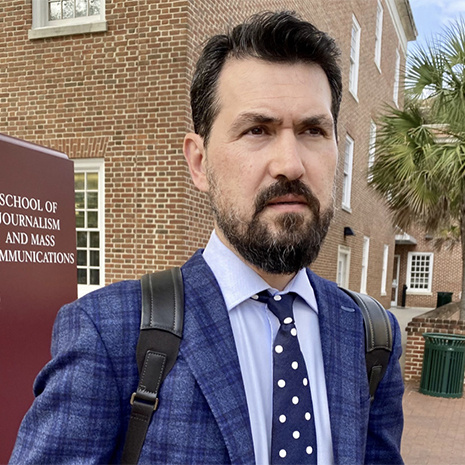
Dan Sultanescu
Dan Sultanescu is a visiting Fulbright Scholar at the University of South Carolina. Sultanescu is the research director of the Center for Civic Participation and Democracy, an academic think tank in Bucharest, România
The global conversation over misinformation, disinformation and fake news is evolving, according to new research from the University of South Carolina Social Media Insights Lab. The use of the term “fake news” exploded worldwide in 2016 with the candidacy of Donald Trump for U.S. president. However, since 2020, the more precise terms of “misinformation” and “disinformation” are being used more frequently.
To conduct this study, I was fortunate to head a team that included people with expertise in communication, journalism, political science and information science at both USC and in SNSPA, Romania.
We reviewed more than 280 million online mentions related to fake news, hate speech, freedom of expression, misinformation and disinformation made over a 10-year period. The lab utilized 17 search queries in seven different languages and three different tools to collect information from several platforms, including Twitter, Facebook, YouTube, various websites as well as Google search data.
The term “fake news” had not been used frequently until 2016. After Trump started referencing it, the term spread across the globe, commonly applied in political contexts. By comparison, the terms “misinformation” and “disinformation” were not commonly used until the second half of 2020, when they often were said in the context of political campaigns as well as high-profile events like the COVID-19 pandemic. The terms continue to be frequently used today.
One of our more interesting findings relates to the timeline. The chronological evolution of the volume of this conversation (illustrated in Fig. 1) highlights that fall 2016 marked a significant increase in the use of these terms and that has remained consistent since then, with several spikes in usage. The first spike came with the 2016 U.S. election. Since then, there have been spikes associated with COVID-19, the 2020 U.S. election, an election in the Philippines and Elon Musk taking control of Twitter.
This is the big picture, but there also were several nuances associated with each search term.
We were especially interested in exploring how the use of “fake news” evolved and in many cases was replaced by more precise terms, such as “misinformation” or “disinformation”. As Fig 2. illustrates, “fake news” had an interesting trajectory, with a high volume of mentions from the end of 2016 to the beginning of 2020, and later dropping substantially after the election of Joe Biden as U.S. president. In the second half of 2020, “misinformation/disinformation” started to be used much more often in online conversations.
The events pointed out on the timeline in Fig. 2 suggest that peaks in the online conversation coincided with elections in the United States (both the 2016 and 2020) as well as in the Philippines.
Looking on a more granular level at the terms “hate speech” and “freedom of expression”, we noticed a much broader spectrum of issues, and contributions from even more regions. Fig. 3 showcases a timeline which includes these additional topics, and we can notice several peaks coinciding with significant events such as the Charlie Hebdo shooting in France and the Capitol riots in the United States.
We further analyzed online search trends and they seem to support our conclusions. Our analysis of Google Trends data related to “fake news” mirrors the general evolution of the topic and highlights the same regional events that coincide with significant peaks in the global conversation (Fig. 4). It is interesting to note that spikes in the global search interest for “fake news” coincide with electoral campaigns in the United States, Brazil and the Philippines, as well as the COVID-19 pandemic.
Our database provides more insights besides volume and general trends - such as language breakdown, top contributors, illustrative high engagement posts and source breakdown. Future analysis can include more in-depth evaluations regarding the potential impact of significant events or specific social media accounts in promoting freedom of expression and fighting hate speech.
As the online environment continues to be a significant forum for people all around the world, malevolent attempts to influence public opinion through false information will become increasingly dangerous. Regulating the online space is an on-going debate as online platforms struggle to deal with the problems. Elections and high-profile events (such as the COVID-19 pandemic) create opportunities to disseminate controversial, unverified content and hate speech.
Platform-related automation processes and algorithms add fuel to the spread of problematic messages, as the noise is amplified by the lack of gatekeeping. After analyzing this large amount of data, it is apparent that efforts to tackle these issues need to intensify and to be more coordinated.
There is a growing need to foster and protect the information environment, as this is essential for safeguarding democracies around the world. Fighting digital disinformation at the same time as protecting freedom of expression in the online environment remains a central challenge for our societies.
The Social Media Insights Lab at the University of South Carolina collected publicly available online data with the help of Brandwatch, CrowdTangle and Google Trends.